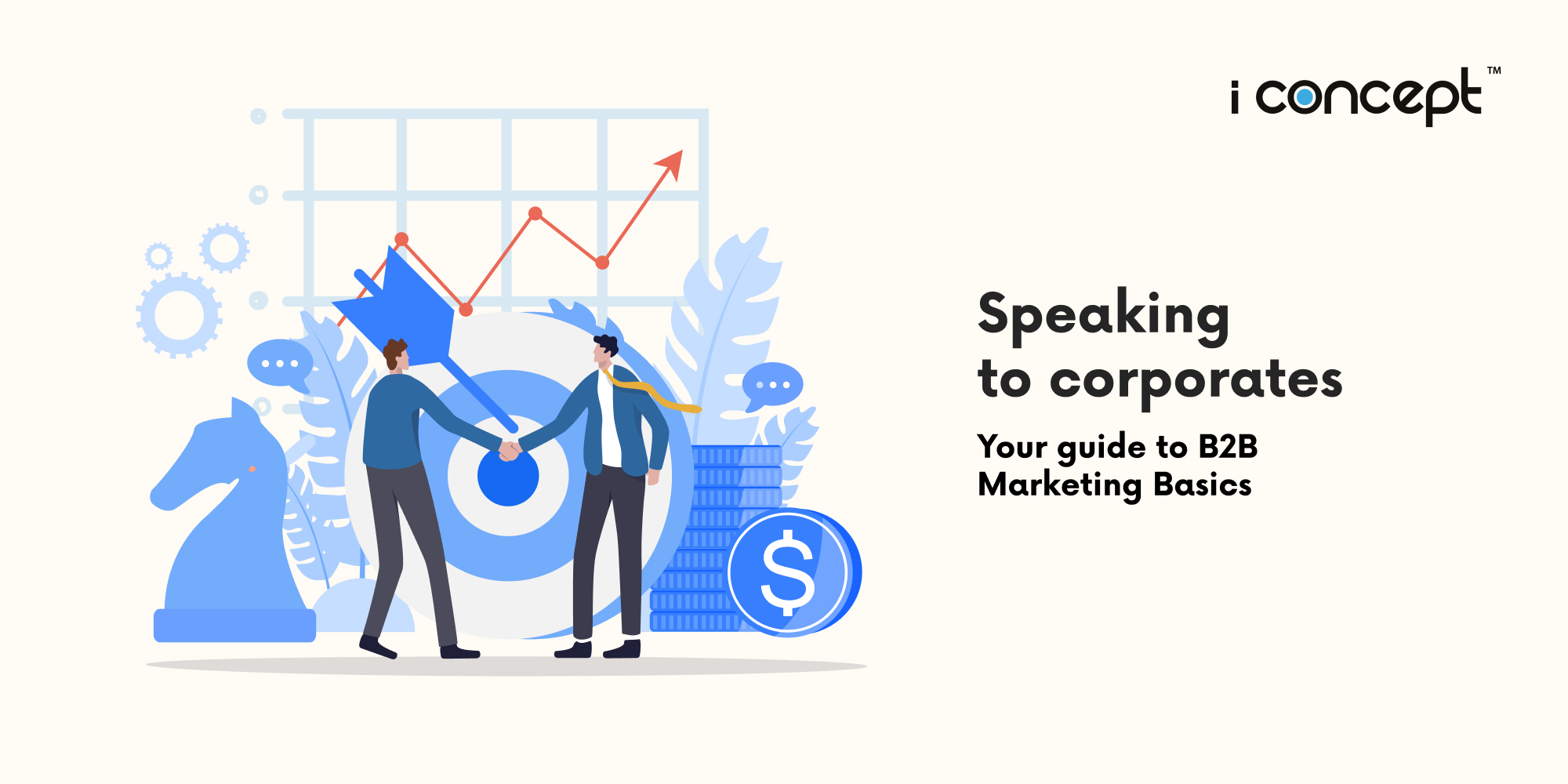Did you know that 64% of B2B companies surveyed across industries have a formal marketing plan? Gone are the days of crossing your fingers and hoping that your products and services will sell themselves. To stay competitive with the rest of the market, you need to have a B2B marketing plan in place to increase and convert as many leads as possible.
We know that creating a marketing strategy and mapping out your plan can be challenging and complex. There are so many tactics available that you can pick, channels to get up and running, and ways to approach your marketing strategy when speaking to various audiences. And admittedly, digital marketing is indeed complex and requires some navigation for the uninitiated.
Thus, we at I Concept have broken it all down, everything you may need to know about B2B marketing. From organising your marketing plan, top strategies to consider, and how you may want to go about executing the strategies, with more organisation and less stress.
Let’s start with understanding the basics.
What is B2B content marketing?
B2B content marketing is the main way B2B companies generate brand awareness and create demand. Seen in many forms and distributed via many channels, it normally involves a combination of text and imagery that create and further the relationship between the business and its desired audience.
Why does B2B content marketing matter?
So much of the buyer journey is taking place online, separate from salespeople. As a result, the content that businesses put out there is massively important. It’s the main way a business can start to build trust and cultivate a relationship with its audience. Producing high-quality, engaging content will keep your audience coming back for more.
Unlike business-to-consumers (B2C), B2B content marketing deals with businesses and the decision-makers within those businesses. This means that the stakes are higher when making purchasing decisions than they might be for B2C. Therefore, it’s extremely important that B2B businesses present themselves as being safe and reliable options. And one of the best ways to do so is to consistently deliver high-quality content (and also services).
But, as much as high-quality content is crucial, we don’t want a preoccupation with professionalism limiting us. We don’t want a perceived ‘B2B-style’ to stop us from creating content that feels human, and that strikes an emotional chord with the audience. We can still afford to be a little more playful with B2B content marketing, and welcome some creative marketing tactics.
Audience: How should I define my audience?
Segmenting your audience into personas is a popular way of doing things. B2B businesses often target multiple personas. It is therefore worth prioritising them, particularly if you’re starting out. That way you can focus on the key personas you want to target as part of your initial content marketing efforts.
Consider breaking your audience down into the groups of people who have power over whether your product or service will be purchased. So these might be:
- The decision-makers. These people have the final say on whether your product/service should be purchased).
- The influencer network. These people are more junior than the decision maker and will create internal demand for your product.
- Senior influencers. These people could be the manager of the decision maker, the finance director, or even the CEO.
The job of the content marketer is to cater their messaging to these different groups. The decision maker and the influencer network are probably a good place to start.
The influencer network tends to be the people doing the research on your brand and trying to find solutions for a problem they have. That means the content that you produce for them is more likely to be at the top of the funnel.
The decision-maker content, on the other hand, is more likely to be middle to bottom of the funnel. It’ll involve helping that decision maker reach the conclusion that they need to buy your product to meet their needs and challenges.
How can I map the content to my audience?
When looking at the buyer journey and the audiences you’re going after, you may get really specific. Note the stages of the buyer journey, each with their unique considerations for content requirements. You could also break up your buyer journey down into three stages: top of the funnel, middle of the funnel, and the bottom.
Focus on how to attract people to your brand. Then educate them on the problem they have and offer them a solution. This approach will give you the foundations you need to hone your content mapping in the future.
Balancing a unique style with searcher intent
Successful content marketing isn’t about keyword stuffing for the sake of SEO optimisation. In fact, Google can spot keyword stuffers from a mile away and will penalise you for it, so don’t be tempted. Instead, you have to consider the reader’s experience and have a unique tone of voice.
That means it’s more effective to write naturally, using a clear and consistent tone of voice throughout that reflects your brand. Good digital copywriting will come into play. Clear and distinct copies help in effective communication. If you do this, you’ll be viewed far more favourably both by Google and, crucially, your readers. They’ll be a lot more likely to return to your site and engage with other content on there.
Strategy: What is B2B content marketing strategy?
A content marketing strategy is a roadmap to help you on your content marketing journey. And it’s important to have one before you start producing content. You need to set out:
- The objectives of your content marketing programme
- The audience you’re targeting
- The pain points you’re looking to address
- The types of content you need to create
- The distribution plan for that content
- The metrics that will be used to measure the success of those activities
Having a well-thought-out plan for what you’re doing, why you’re doing it and how it’s going to benefit the business is crucial. It means you can justify why you’re producing the content and make a case for it when budgetary decisions are made. This is especially important when you consider that marketing is scrutinised more closely than most functions in a business.
How do I create a B2B content marketing strategy?
There’s so much to consider here, so I’m going to go through four key stages which are all really important when it comes to creating an effective B2B content marketing strategy.
- Who: First and foremost, you need to be clear on who your content is for. As we discussed earlier with buyer journey mapping, you need to have a really clear understanding of the personas you’re targeting. This will influence the type of content you produce and your distribution channels.
- What: Once you’ve documented who you’re targeting, you need to start mapping out your goals. It’s always a good idea to map this back to any overarching marketing or business goals.
Before you start mapping out specific pieces of content you need to produce, make sure you’re clear about what you’re setting out to achieve. Is it brand awareness, is it lead generation, or is it sales enablement?
Always have a clear brand identity before you set out. Because essentially, you are selling your branding above all else.
- Where: Once you know what you’re planning to publish, you can start thinking about which channels are best for distribution.
Go back to your target audience and ask yourself where these people are hanging out. This will give you the answer about where’s best to publish your content. For example, if you’re creating a blog post, it might be best to go out on social media. And perhaps you could also incorporate it into an email newsletter.
Make sure your content is seen by the people you want it to be seen by. Wherever your target audience is, that’s where you want to prioritise.
- How: A lot of content marketers often stop short of this step, but it’s one of the most critical parts of content marketing.
Now you have a clear idea of who you’re targeting, what you want to achieve, what you plan
to produce and where you’re going to push it, you need to set goals for individual content
pieces. So if you’re planning to create a blog post, what are you trying to achieve? Is it the
number of reads, ranking for particular keywords or backlinks?
This is crucial because it provides a feedback loop. And without setting specific goals, there is
no way of judging whether or not a piece of content has been successful. If it has been
successful, you can do more of it. If it hasn’t, it’s time to tweak it, optimise it, or completely
overhaul it until you find a better formula.
Content types: Is blogging everything?
Sure, blogging should be a part of your thinking. They’re a great way to test if there’s demand for what you’re talking about. But if you get loads of engagement on a particular topic, you should be thinking about repurposing. For example, you could write a report off the back of a popular blog, create an infographic or host a webinar. The list is endless. So don’t let your blog be the beginning and the end of your thinking.
Metrics: What should you be tracking?
It’s so important to look beyond simple vanity metrics when measuring whether the content is successful. Vanity metrics are ones which just don’t dig deep enough and only tell you part of the story. A lot of content marketers will use metrics like impressions, clicks, or downloads to measure whether the content is successful. But are these really the most accurate metrics to determine success?
Take downloads, for example. A download doesn’t actually tell you whether a person has read the content. It tells you that they downloaded it, yes. But perhaps they opened it and then closed it straight away without reading any of it. Or perhaps they opened it, and planned to come back to it later but never did.
We really need to dig deeper. We need to understand how people are reading that content, whether there were certain parts that they engaged with more than others, at which point they bounced off, and whether they interacted with any of the elements within it.
These are the sorts of things that will help you to figure out whether what you’re doing is working or not, or indeed whether there are specific parts that readers are engaged with more and so might warrant a spin-off piece of content. But you won’t know any of this crucial info if you only place emphasis on these vanity metrics.
Getting a partner to assist in your B2B content marketing
Looking for assistance to create a dynamic B2B content marketing strategy for your brand? Or are you just not too sure how to go about creating suitable content for your business’ digital channels and socials? I Concept Singapore is here to assist!
As a leading creative social media agency, we offer a range of digital solutions, from website and e-commerce store design, and comprehensive digital marketing and social media strategy advice. We can also help carve out your brand identity, and provide follow-up social media management services. Our team of creative strategists, writers and designers will be on hand to help you with your digital marketing needs. Speak with us today!
